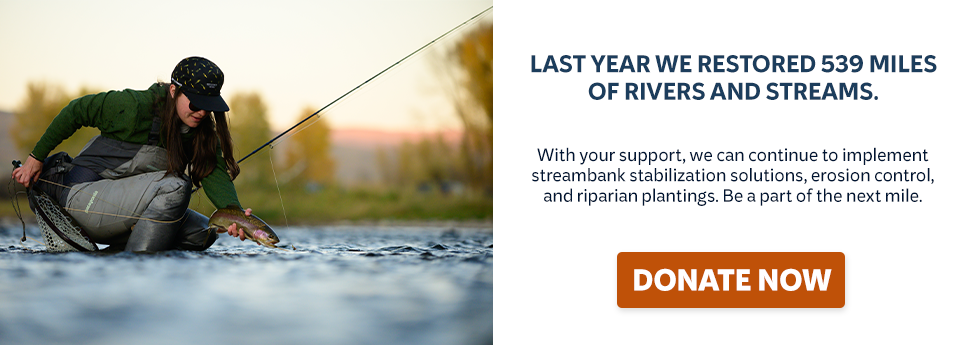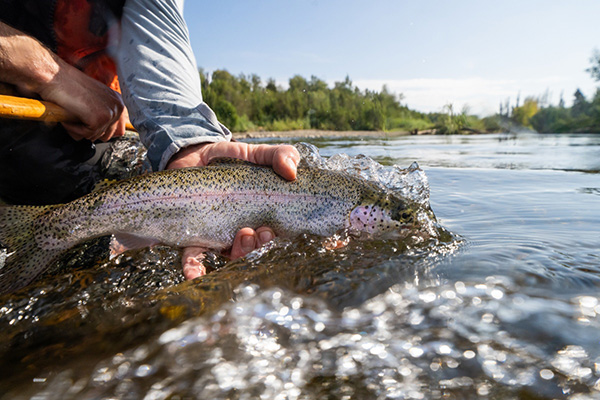Social media like Facebook, Instagram, Twitter and other platforms provide a free, easy way for your chapter to reach more and new audiences, grow awareness of your work and attract and invite new members and volunteers. It can also help you connect with different folks, especially those younger than the typical TU demographic.
There are many great online trainings available on the mechanics of setting up your chapter’s Facebook page or Instagram account, and your Volunteer Operations Staff is always here to help you get started with a social media policy to guide your team’s efforts.
Social Media “Rule of Five”
In social media training circles, the common theory is that to be effective on social media, you should follow the “Rule of 5”.
What that means is that for every post you put out asking for an action from your followers – whether that be to donate, bid in an auction, volunteer for a project, or sign a petition or advocacy letter – you should also put out at least four other posts that share something with no “ask” involved. You can share articles from the blog on www.tu.org, links to articles from state conservation agencies, videos from a fishing website, posts from aligned conservation groups and partners and more.
The important thing is that your followers come to learn that your social media is a place they can come regularly to find great content that is relevant to them and not just see the same messages they saw in the chapter email that week.
Tips for Effective Social Media
- Pictures & Videos Increase Eyeballs
Images and videos have 10-times as much engagement – likes, shares, comments – than static posts with no image or video. Images and videos stop the eye on the “social scroll” and invite your audience in to read more, learn more, click through and get active. Consider the impact of post language and imagery as you review your customized social media policy to guide your messaging. - Join Your Social Community
Social media is not just another loudspeaker – a way for you to send out your meeting notices, event listings and calls to action. It should be a two-way dialogue between you and your followers that feels more like a conversation among friends. Some ways to set this tone on your social media is by mentioning members who volunteered in posts, liking posts and comments made on your page, ask questions of your followers and commenting on their responses, encourage your followers to post their own fishing reports, photos and updates on your pages and groups. - Share & “Steal” Liberally
Simply sharing great posts from TU.org, other fishing and conservation groups, partners like land trusts, watershed associations and others is a fast and easy way to help with the “Rule of Five” above by providing a constant stream of content on your social media channels. Even better, as you share their stories, photos and videos, they too will begin to share yours, helping you reach even more people of like mind who are prospective members and supporters. - Promote & Cross Link
A strong social media following doesn’t happen overnight. It takes time, effort and a strategy. Following the steps above to push out compelling content on a regular basis will help people find you organically, but you also need to always be promoting your social media channels in other communications. Be sure to prominently link to your social media from your website, emails and even in your print mailings. Ask local partners like fly shops, guides, watershed groups and more to share your links to social media as well. - Know Your Capacity
You can’t “do it all”, nor should you. So focus on the social media channel(s) you can manage well and be in it for the long haul to build and grow your audience, keep posts up to date, and drive your social media strategy forward. It’s better to have a vibrant and active Facebook page and nothing else, than to have a Facebook page, Instagram account, Twitter handle and have them all be stale and out of date.
Social Media – Board Best Practices
- Ensure At Least Two People Always Have Access
Always have at least two current board members with full access to your Facebook, Instagram, and other social media accounts. This ensures continued access if someone is unavailable, leaves the board, or the like. - Avoid Sharing Passwords (where possible)
While we want to ensure multiple board members can fully access social media, where possible, provide such access by adding people to the Page with their own Facebook profiles. Instagram access can also be managed through a linked Facebook page. - Be Cautious with Account Roles
Only give full admin access to people who need it on a consistent basis. Others can often be given roles that allow them to post without being able to lock others out. Or simply have someone interested in posting coordinate such post with your chapter’s go-to social media person! - Update Access During Transitions
The same way its important we keep leader rosters updated in the Leaders Only Section, we should also be sure to similarly update social media access. When someone leaves the board (or changes roles), or is added to the board, make sure to review who has access to social media accounts and update accordingly. If a social media admin leaves the board, be sure to obtain and verify account access info (e.g. make sure it actually allows you to login) before they leave the board. - Keep a Record
Maintain a list of who currently has access to social media accounts, which accounts they have access to and at what level (e.g. admin, contributor, etc.), and usernames/passwords. Review this regularly, but particularly when board members are coming onto or off of the board.


